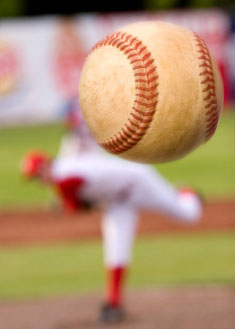
The pitcher varies the ball’s vertical motion largely by controlling its spin, says physicist Roger Tobin. Photo: iStock
Ask The Professor
Why do sinker balls sink—and curve balls curve?
Roger Tobin, a professor of physics in the School of Arts and Sciences, fills us in:
It’s a cliché that “baseball is a game of inches,” but for hitters and pitchers, it’s more a game of millimeters. If the bat hits the ball a fraction of an inch too low or too high, the result is a popup or weak ground ball instead of a solid hit. A major league fastball reaches the plate in about four-tenths of a second, and the batter must commit to his swing when the ball is about halfway to the plate by anticipating where the ball will be when it gets there. Much of a pitcher’s art lies in making the batter misjudge—even slightly—the height at which the ball will cross the plate.
The pitcher varies the ball’s vertical motion largely by controlling its spin. The ball always drops because of the downward force of gravity. But if the ball is thrown with backspin, with the top of the ball rotating back towards the pitcher, the air pushes upward and the drop is reduced. With overspin—the top rotating forward towards the batter—the air pushes down, enhancing the natural drop due to gravity.
If you throw a ball hard overhand, it will naturally roll off your fingers and come out with considerable backspin, and that’s what most fastballs do. As a result, they drop less, and follow a flatter trajectory, than they would without spin. Baseball folk call it a “rising fastball,” but it doesn’t really rise; it just doesn’t fall as much as you’d expect.
Batters, of course, learn to adjust for the flattened trajectory, so pitchers find ways to throw pitches that look like fastballs, but with little or no backspin. The “sinker” is thrown with a grip-and-wrist motion that gives the ball sidespin instead of backspin. Forkballs and split-finger fastballs minimize backspin because the fingers are placed along the sides of the ball instead of over the top. All of these pitches “sink” only because of gravity. But if the batter is anticipating the flatter path of a normal fastball, he’ll swing too high, missing it or hitting a ground ball, and swear that “the bottom dropped out” of the pitch.
To get even more drop than gravity alone would cause, the pitcher needs to throw the ball with overspin—that’s a curve ball. It requires a difficult and unnatural motion in which the palm and fingers roll forward over the top of the ball as it’s released. It’s also thrown more slowly than the fastball, so gravity has more time to act, further accentuating the drop.
Most pitchers focus on the vertical motion of the pitch because that’s where the batter’s margin of error is smallest. But the spin is rarely perfectly aligned, and most pitches also have some side-to-side motion, moving toward or away from the batter as well as down, and that provides another tool in a pitcher’s arsenal of tricks.
Players and commentators often talk about pitches with “late movement” or of a pitch “falling off the table” or “disappearing” at the last moment, as though the ball made a sudden change of direction just before reaching the plate. This is an illusion. Except for knuckleballs, all the pitches follow smoothly curving trajectories. Physicists have said this for years, and players have scoffed. But now there are pitch-tracking cameras in every major league ballpark, and you can view the trajectories on your computer and see for yourself.
But the effects build up over time—it’s a property of motion with a constant force—so that most of the “break” occurs at the end of the pitch, often when it’s too late for the batter to adjust his swing. The trajectories of the various pitches differ very little until the ball is more than halfway to the plate, so the batter has to recognize the type of pitch and anticipate its motion based on other cues. It’s remarkable that anyone can do it at all, let alone as consistently as the best hitters do.
For more about these and many other topics, I strongly recommend Robert Adair’s book The Physics of Baseball (It Books, 2002).

